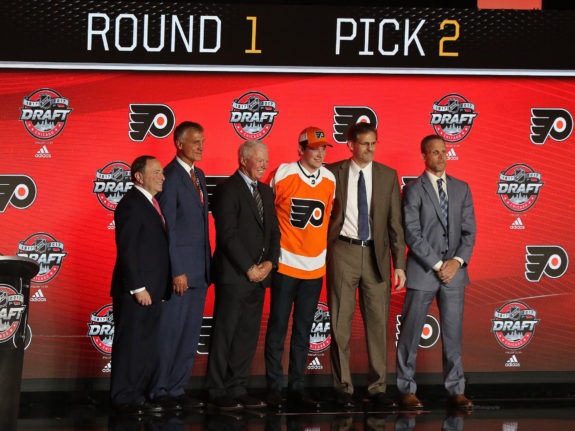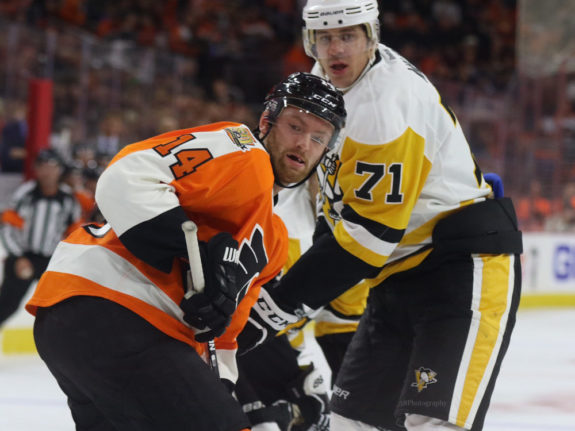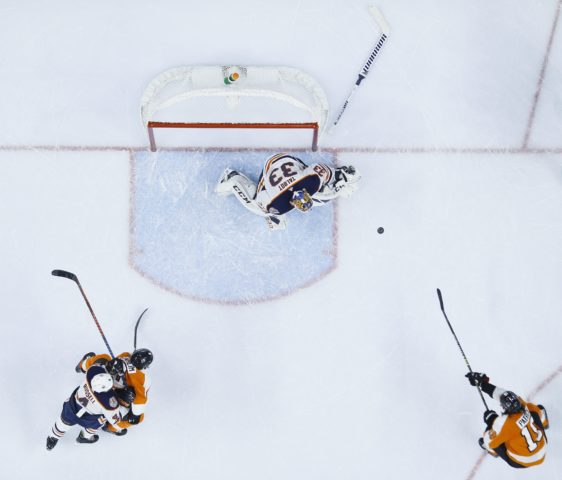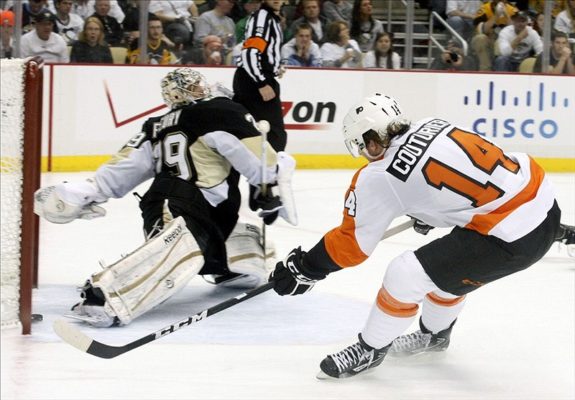Heading into his third NHL season with the Philadelphia Flyers, expectations will be high for the former second-overall pick, Nolan Patrick. After two underwhelming seasons, many are looking for Patrick to show growth on the ice and on the stat sheet this season.
While every player’s career has its own path, so far, Patrick’s can be compared to teammate Sean Couturier. A question that remains unanswered is if Patrick’s career will blossom the way Couturier’s has in recent years.
By the Numbers: Patrick and Couturier’s First Two Seasons
Both Couturier and Patrick were high first-round draft picks: the former was picked 8th overall in 2011 and the latter was 2nd overall just two seasons ago.
Couturier and Patrick each broke into the league right after being drafted and both played their first NHL seasons as 19-year-olds. The similarities don’t end there.
Couturier and Patrick also posted nearly identical statistics in their rookie seasons. Couturier ended his rookie campaign with 13 goals and 14 assists, playing in 77 games. While, in Patrick’s rookie year, he scored 11 goals and added 17 assists in 73 games.

As far as advanced stats go, Couturier finished with a Corsi For percentage (CF%) of 48.9 in his first full NHL season, while Patrick finished just below that in his rookie year, with a 48.8 CF%.
Couturier’s sophomore season was a wash, as the 2012-13 NHL lockout shortened the season to 48 games. However, the next season, playing in all 82 games, Couturier tallied 13 goals and 26 assists. Last season, Patrick’s second full season in the NHL, he played in 72 games finishing with 13 goals and 18 assists.
Couturier’s CF% went down a bit, to 48.8 in his sophmoreseason. Alarmingly, Patrick’s CF% dropped also, to 46.8 despite playing increased minutes with more talent around him. However, as we’ve seen with Couturier, a players’ first two seasons rarely tell the story of how they will develop.
Flyers’ High Expectations
Make no mistake, being a high draft pick comes with expectations, no matter the place. However, in Philly, a place where the fan-base is notoriously tough, players picked inside the top 10 are expected to do big things and in fast order.
In Couturier’s rookie year, the Flyers’ success helped him avoid much flack. Though, the chirping about whether he was the right draft choice began then. He earned a reprieve of sorts after a stellar performance in the playoffs that year, mainly in the opening round against the Pittsburgh Penguins where he famously gave Evgeni Malkin fits the entire series.

Compared to Couturier, expectations for Patrick entering his rookie season were understandably higher. When you’re drafted second overall, that’s going to happen.
The hype ramps up another notch when other players from the same draft class find success. Elias Pettersson, selected three picks after Patrick by the Vancouver Canucks, posted a 66-point season in his rookie year, albeit a season later than Patrick’s debut in the show.
Couturier’s overall game took time to evolve, however there were things he was able to do almost immediately at an elite level. He has the kind of skills that don’t always jump out on the stat sheet. Though, even his stellar penalty killing and defensive skills overall didn’t protect him from the Flyer faithful’s venom and while his game has begun to flourish on the offensive end over the last few seasons, the stigma has yet to fully dissipate.
This is what Patrick is up against, which is important to note. However, placed in a similar position as Couturier, there’s reason to believe Patrick’s game could make the same kind of jump, perhaps at an even quicker pace than his counterpart.
Comparing Couturier and Patrick
Patrick’s career is best described as equal parts intriguing and frustrating.
If you look at how he scores his goals and assists, you’d think a breakout should be around the corner. However, if you look at his overall production, you might scratch your head.

Patrick predominantly makes his living by dominating the front of the net, especially when scoring goals. Most players who feast around the net are assumed to be “muckers and grinders” who largely score “garbage goals.” This couldn’t be farther from the truth with Patrick, who shows strength, a high hockey I.Q., touch and soft hands when creating his chances. Yet, despite his skills, he’s streaky.
Patrick started his rookie season sluggishly, earning just 13 points in his first 48 games. The high-mark for Patrick came well after that; from late February to early March in 2017-18, he earned at least a point in five straight games. He later had a solid 12-game stretch when he finished with 5 goals and 5 assists. He also finished the season strong, posting seven points in the final 13 games. However, overall he had only three multi-point games during the season.
In 2018-19, though his production remained mostly the same, his streaky play was even more glaring while playing second-line minutes. He tallied points in consecutive games just four times, after six such instances his rookie year.
Patrick had another slow start in the 2018-19 season, failing to record a point in the season’s first four games. However, he found his footing quickly, with points in seven of the next 10 games (5 goals, 4 assists). He was pointless in the next 10 games after that. After scoring nine points in his first 14 games last season, Patrick scored 8 goals and 14 assists over the remaining 58 games.
Early in his career, Couturier also struggled with consistency when it came to offensive production. Over his first two full NHL seasons, he posted points in consecutive games 12 times, compared to Patrick’s 10.

Similar to Patrick, most of Couturier’s offensive damage comes in front of the net. Both use their vision and smarts to be in the right place, usually in the most dangerous spots. Eventually, that work paid off for Couturier, and the same could happen for Patrick.
Over the last two seasons, Couturier’s offensive game has exploded. While some would argue that playing on the top line with Claude Giroux would help anyone, Couturier’s progress on offense is hard to ignore.
Over his first six seasons, he averaged only 11 goals and 20 assists per season. In the last two seasons, he’s averaged 32 goals and 44 assists, a significant jump in production. Also, after averaging just a 9.2 shooting percentage over his first six seasons, that percentage has increased to 14.2 over the last two seasons. Furthermore, he has been extremely consistent, tallying points in consecutive games a remarkable 25 times over the 2017-18 and 2018-19 seasons.
Patrick’s Potential in 2019-20
For any player entering their third NHL season, the game should seem slower, the bright lights dimmer and the distractions now firmly in the rear-view.
While it may be unrealistic to expect a major breakout for Patrick this year, Flyer fans should definitely see an improvement in his numbers from the past two years.
What is possible to expect this season for Patrick are career highs in goals and assists along with an improved shooting percentage. If that does indeed happen, the Flyers may have another Couturier-like player on their hands.
In Couturier’s third full year in the NHL, he scored a career high 15 goals and improved his shooting percentage from 7.9 % the previous season to a 10.1 % despite taking 20 less shots on goal. In reality, this was the point where Couturier’s career started to rise on the offensive end.

The following season, even though he played just 63 games, Couturier managed to post a career high in points (39); in the 2016-17 season, Couturier’s numbers stayed consistent as he posted 34 points and earned the highest shooting percentage of his career at the time, 11.7.
Then came the breakout for Couturier, who posted two straight 30-plus goal and 40-plus assist seasons, while also finishing with a shooting percentage of 13.7 and 14.8 in those seasons, respectively.
Heading into the 2019-20 season, Patrick will not only have 145 pro games under his belt, but he may also have a greater chance at success being more acclimated to the NHL game.
Patrick isn’t a one-trick pony. Like Couturier, Patrick has shown two-way player ability and above average passing skills, which should benefit him in his third season. After being pushed, perhaps too early, into second-line minutes last year, Patrick should see most of his minutes this upcoming season on the third line. Playing there, he’s likely to see more production, much like Couturier saw in his third full NHL season.
Also, Patrick is a prime candidate to see more penalty killing minutes, which were Couturier’s bread and butter early in his career. Arguably, playing some of the toughest minutes on the ice may have stunted Couturier’s offensive growth, but over time it clearly made him a better player as the stats show.
Taking a comparable career path to Couturier’s, it’s not beyond reason to believe Patrick could one day become a similar, if not a better player, this season and in the years to come.